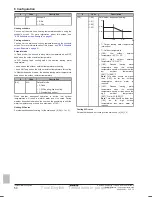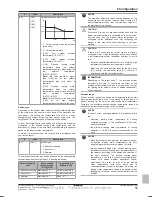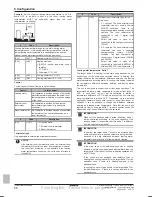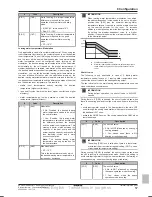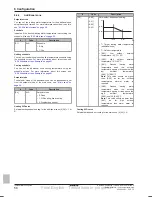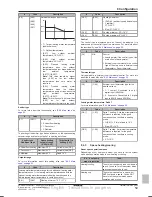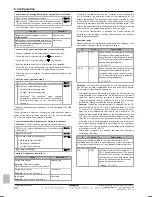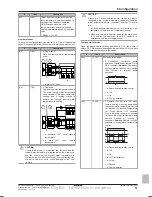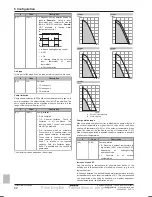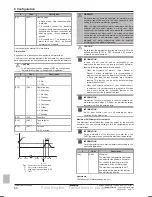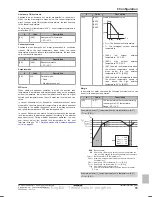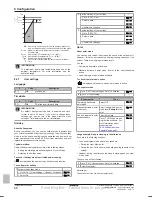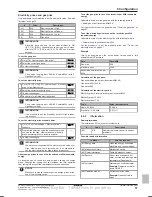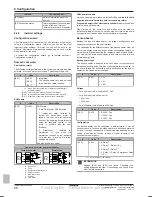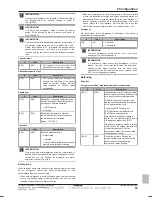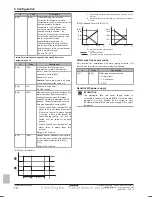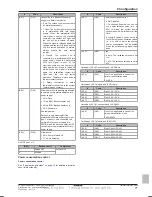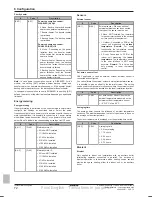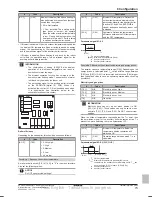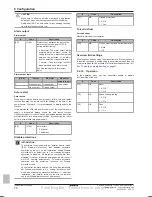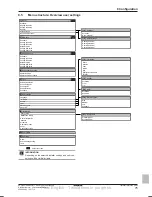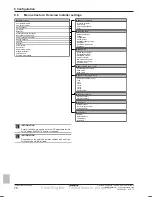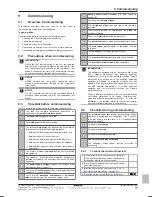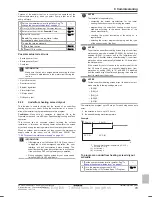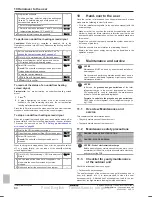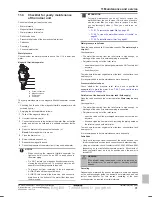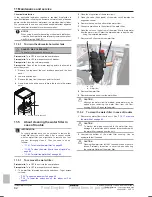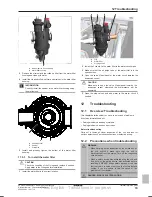
8 Configuration
Installer reference guide
68
ERGA04~08DAV3(A) + EHVH/X04+08S18+23DA
Daikin Altherma – Low temperature split
4P495248-1 – 2017.12
In menu…
You can read out…
[8.7] About
Version information about the
system
[8.8] Connection status
Information about the connection
status of the unit, the room
thermostat and the LAN adapter.
8.4.9
Installer settings
Configuration wizard
After first power ON of the system, the user interface will guide you
using the configuration wizard. This way you can set the most
important initial settings. This way the unit will be able to run
properly. Afterwards, more detailed settings can be done via the
menu structure if required.
To restart the configuration wizard, go to Installer settings >
Configuration wizard [9.1].
Domestic hot water
Domestic hot water
The following setting determines if the system can prepare domestic
hot water or not, and which tank is used. This setting is read only.
#
Code
Description
[9.2.1]
[E‑05]
(*)
[E‑06]
(*)
[E‑07]
(*)
▪ Integrated
The backup heater will also be used
for domestic hot water heating.
(*)
Menu structure setting [9.2.1] replaces the following 3
overview settings:
[E-05]
Can the system prepare domestic hot water?
[E-06]
Is a domestic hot water tank installed in the system?
[E-07]
What kind of domestic hot water tank is installed?
DHW pump
#
Code
Description
[9.2.2]
[D‑02]
DHW pump:
▪ 0: No DHW pump: NOT installed
▪ 1: Instant hot water: Installed for
instant hot water when water is
tapped. The user sets the operation
timing of the domestic hot water pump
using the schedule. Control of this
pump is possible with the user
interface.
▪ 2:
Disinfection
:
Installed
for
disinfection.
It
runs
when
the
disinfection function of the domestic
hot water tank is running. No further
settings are needed.
See also illustrations below.
Domestic hot water pump installed for…
Instant hot water
Disinfection
c
f
b
a
g
c
b
a
d f
e g
a
Indoor unit
b
Tank
c
Domestic hot water pump
d
Heater element
e
Non‑return valve
f
Shower
g
Cold water
DHW pump schedule
Here you can program a schedule for the DHW pump
(only for field
supplied domestic hot water pump for secondary return)
.
Program a domestic hot water pump schedule
to determine when
to turn on and off the pump.
When turned on, the pump runs and makes sure hot water is
instantly available at the tap. To save energy, only turn on the pump
during periods of the day when instant hot water is necessary.
Backup heater
Besides the type of backup heater, the voltage, configuration and
capacity must be set on the user interface.
The capacities for the different steps of the backup heater must be
set for the energy metering and/or power consumption feature to
work properly. When measuring the resistance value of each heater,
you can set the exact heater capacity and this will lead to more
accurate energy data.
Backup heater type
The backup heater is adapted to be connected to most common
European electricity grids. The type of backup heater must be set on
the user interface. For units with a built-in backup heater, the type of
heater can be viewed but not changed.
#
Code
Description
[9.3.1]
[E‑03]
▪ 2: 3V
▪ 3: 6V
▪ 4: 9W
Voltage
▪ For a 3V model, this is fixed to 230V, 1ph.
▪ For a 6V model, this can be set to:
▪ 230V, 1ph
▪ 230V, 3ph
▪ For a 9W model, this is fixed to 400V, 3ph.
#
Code
Description
[9.3.2]
[5‑0D]
▪ 0: 230V, 1ph
▪ 1: 230V, 3ph
▪ 2: 400V, 3ph
Configuration
The backup heater can be configured in different ways. It can be
chosen to have a 1-step only backup heater or a backup heater with
2 steps. If 2 steps, the capacity of the second step depends on this
setting. It can also be chosen to have a higher capacity of the
second step in emergency.
#
Code
Description
[9.3.3]
[4‑0A]
▪ 0: Relay 1
▪ 1: Relay 1 / Relay 1+2
(a)
▪ 2: Relay 1 / Relay 2
(a)
▪ 3: Relay 1 / Relay 2 Emergency Relay
1+2
(a)
(a)
Not available for 3V models.
INFORMATION
Settings [9.3.3] and [9.3.5] are linked. Changing one
setting influences the other. If you change one, check if the
other is still as expected.
Final English - Tanslations in progress

